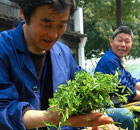Op-Ed Contributors
Dalai Lama group flounders in rebuffing Tibetan serfdom
By Zhang Yun (China Daily)
Updated: 2010-02-23 07:56
 |
Large Medium Small |
The article of the Dalai Lama group also states that "throughout her history, Tibet never experienced famine and the number of beggars could be counted with your fingers." In fact, due to its low levels of abilities to resist natural disasters, and the reign of the corrupted feudal serfdom under theocracy, old Tibet was hit by various levels of winter disasters as well as wars and plagues nearly every year. Aside from Buddhist prayers, there was no effective way to deal with those natural and manmade disasters, which often led to famine, mass deaths of people and livestock, widespread disease and the rampant presence of beggars. Flocks of beggars, including the old, women and children, could be seen in Lhasa, Xigaze, Chamdo, and Nagqu in old Tibet. According to statistics, of the 37,000 people living in Lhasa before the peaceful liberation of Tibet, about 5,000 were beggars.
c. Glorifying monasteries under the theocracy in old Tibet as a model of traditional moral life.
The article claimed that "the role of monasteries as highly disciplined centers of Tibetan education and intellectual hubs was central to the traditional Tibetan way of life." But in fact, before the Democratic Reform of Tibet, monasteries occupied about 1.21 million ke of farmland (15 ke equal to 1 hectare) and possessed large numbers of livestock and pastures.
The three monasteries of Drepung, Sera and Gandan housed over 10,000 monks, with a possession of 321 estates, up to 10,000 ke of farmland, 450 pastures, 110,000 livestock and more than 60,000 serfs. Monasteries were also the biggest usurers, lenders of money at unlawfully high rates of interest, in old Tibet.
According to the book Tibetan Interviews, by American journalist Anna Louise Strong, one-fourth of Drepung monastery's total income came from usury lending, with an interest rate much higher than the apparent 20 percent.
Strong said that when herdsmen could not afford to pay back the loans, they would enter serfdom for 25 years, of which only a few could survive the hard living conditions.
The late 10th Panchen Lama once said in April 1988, when interviewed by National Unity magazine, that in old Tibet monks and landlords had prisons and private jails.
"The punishment was extremely savage and cruel at that time, including the gouging out of eyes, the chopping off of hands or legs, the pulling out of tendons and drowning. Gandan, one of the biggest monasteries in Tibet, had lots of torture instruments such as handcuffs, fetters and sticks," he said.
The fact that old Tibet was ruled by theocratic feudal serfdom is undeniable. The reason why the Dalai Lama group tries so hard to defend the social system of old Tibet is that they have always stood for the backward theocratic feudal serfdom, representing the interests of feudal serf-owners. They staged an armed separatist rebellion in 1959 to try to save the system. And they have never given up their dream of restoring serfdom rule in Tibet since they fled abroad.
Nowadays, the dark rule of the theocratic feudal serfdom in old Tibet has been examined more and more, which forces the Dalai Lama group to create all kinds of lies to cover the truth and defraud the public.
(China Daily 02/23/2010 page8)









